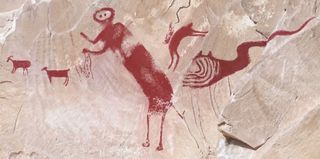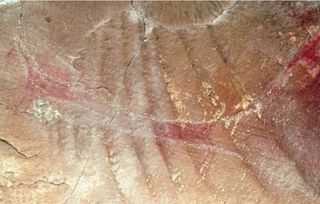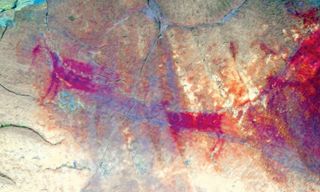'Winged Monster' Rock Art Finally Deciphered

The mystery surrounding the ancient rock paintings of Utah's Black Dragon Canyon has finally been solved. For decades, researchers and creationists have debated whether the vibrant red pictographs are images of humans and animals, or rather, depictions of a large winged monster, possibly a pterosaur.
Now, using cutting-edge technology, researchers suggest the red paintings show five separate images, including a tall bug-eyed person, a smaller person, a sheep, a dog and a serpentlike figure.
"It is not a single figure. It is not a pterodactyl," said co-lead researcher Paul Bahn, a freelance archaeologist. "It's a beautiful set of images." [See Photos of the Rock Paintings from Black Dragon Canyon]
The rock paintings belong to the agrarian Fremont culture (circa A.D. 1 to 1100). Other Fremont rock paintings — known as Barrier Canyon style — show abstract humanlike figures with elongated bodies and round heads, the researchers wrote in the study. These long figures are usually accompanied by tiny "attendants," including people, birds and four-legged creatures, such as hoofed animals, canines, felines, badgers and bears.
Amateurs discovered the painting in 1928, and soon after talk of the "winged monster" arose. In 1947, a man named John Simonson traced over the paintings with chalk and said the end result looked like "a weird bird."
Chalking rock art was a common practice in earlier years — ancient rock art is usually faint, and chalk can help make it visible — but today it's illegal, Bahn said.
"It's one of the worst things you can do, because it damages the art, it imposes what you think you can see on it, it messes up the chemistry of the rock, probably, and it just doesn't disappear," Bahn told Live Science.
Sign up for the Live Science daily newsletter now
Get the world’s most fascinating discoveries delivered straight to your inbox.
Intriguing interpretations
The chalking may have influenced subsequent viewings of the art. Rock-art specialist Polly Schaafsma said she saw a "beak lined with sharp teeth" in a 1970 report. In 1979, geologist Francis Barnes said it looked "very much like a pterosaur, a Cretaceous flying reptile."

The fossils of pterosaurs, flying reptiles that lived from 228 million to 66 million years ago, are found in the region. Some creationists began saying that the painting was a real-life impression of pterosaurs that lived at the same time as humans, and a few people even tried to identify the species, saying it was Quetzalcoatlus northropi, a reptile with a wingspan of about 39 feet (12 meters), Bahn said. (Many creationists believe the Earth is just several thousand years old, instead of about 4.5 billion years old, and as such humans and dinosaurs would have lived together.)
But to many researchers, the painted area clearly shows separate images, not a single image of a pterosaur.
"I myself visited the site in person a few years ago," said Phil Senter, a professor of biology at Fayetteville State University in North Carolina, who was not associated with the study. "There's no pterodactyl there at all. It's a collection of other images."
Benjamin Smith, a professor of world rock art at the University of Western Australia, stressed that humans knew little about dinosaurs and other extinct animals until the 1800s, long after the Fremont culture people painted Black Dragon Canyon.
"Since Native American art is of spiritual significance and holds significant religious content, images can also depict magical and mythical subject matter," said Smith, who was not involved with the study. "Not all animals in Native American art therefore need to depict real-world creatures. Some will be supernatural, but none will be dinosaurs."
Novel techniques
Bahn and his colleague Jean-Loïc Le Quellec, a rock-art expert at the French National Centre for Scientific Research, traveled to Black Rock Canyon for their new TV documentary series, "On the Rocks," in which they feature rock art from around the world. [Gallery: See Amazing Images of Cave Art]

Other experts have written studies that attempt to debunk the creationist pterosaur interpretation, but the new study is the first to use cutting-edge techniques, including a tool called DStretch and a portable X-ray fluorescence device, Bahn said.
With DStretch, researchers can photograph a pictograph and upload it onto a computer. The program then helps researchers highlight the original pigments in the painting, in this case ochre, even when the colors aren't visible to the naked eye. Users can also disentangle colors from unwanted additions, such as chalk.
"Where you've got paint that has faded over the hundreds or thousands of years, DStretch will make them very clear and very visible," Bahn said.
The DStretch results showed "very clearly that these are a set of separate figures," he said. "What was supposed to be one wing of this pterodactyl is actually two little four-legged animals. The so-called head and beak and neck of the pterodactyl [are] actually a human figure with its spindly legs and its two arms stretching out."
Marvin Rowe, a rock-art expert and professor emeritus of chemistry at Texas A&M University, scanned the cave art with portable X-ray fluorescence, which reveals an artifact's chemical makeup.
"He showed that where there are paintings, you get a tremendously high reading of iron, of course, because it's iron oxide, this paint," Bahn said. "In other areas, between the so-called neck of the pterodactyl and its body, there's nothing, because there is no paint there."
With these two methods — the DStretch and the X-ray fluorescence — the researchers say in the study that they removed the "interpretational bias" that is inherent with eyeballing rock art, and used a scientifically replicable process instead.
But the pterosaur perception will likely continue to linger, Bahn said.
On the new documentary, the researchers invited a creationist to view their results. "We were all very polite to each other, and he showed us what he thought he saw on the wall," Bahn said. "We said, 'It looks like a number of separate figures to us.'"
"He said, 'No no, no, I've had this checked out with infrared, and the whole thing is one single painting. It's a very detailed painting of a pterodactyl,'" Bahn recalled.
That idea is outlandish, especially because the separate images are easily seen with the naked eye, Bahn and other rock-art experts said.
"Things are sometimes exactly what they seem to be," Senter said.
The study was published in the August issue of the journal Antiquity.
Follow Laura Geggel on Twitter @LauraGeggel. Follow Live Science @livescience, Facebook & Google+. Original article on Live Science.

Laura is the archaeology and Life's Little Mysteries editor at Live Science. She also reports on general science, including paleontology. Her work has appeared in The New York Times, Scholastic, Popular Science and Spectrum, a site on autism research. She has won multiple awards from the Society of Professional Journalists and the Washington Newspaper Publishers Association for her reporting at a weekly newspaper near Seattle. Laura holds a bachelor's degree in English literature and psychology from Washington University in St. Louis and a master's degree in science writing from NYU.